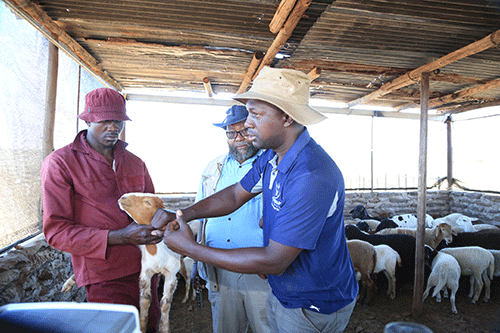Erastus Ngaruka
Small Stock production in Namibia faces significant health challenges mostly associated with parasitism or parasite infestations. The parasites are in two categories, internal and external parasites, and their prevalence is seasonal or depends on the prevailing environmental conditions.
For example, internal parasites include tapeworms, roundworms, and flukes whereas external parasites are ticks, lice, fleas, mites, and flies. The prevalence of these parasites is seasonal, where some prevail in winter and some prefer the summer months for their survival.
In addition, parasites are host-specific, their survival or completion of their life cycle is dependent on the host availability. Other predisposing factors to parasite infestation is related to poor management of the kraal environment and the absence of or an inappropriate parasite control programme amongst others.
Parasite infestation results in huge production and economic losses for smallstock farmers in the country. Moreover, the control measures are cumbersome to some farmers who may not understand or have limited knowledge of the types of parasites, life cycles, seasonality, symptoms, and remedial actions to follow.
Parasite infestation can be detected by marked symptoms or changes in the animal condition and behavior, and through closer inspection of their presence on the body. Some of the parasite activities on an animal include blood sucking, feasting on skin, hair, and pre-digested feed in the rumen. The most common symptoms include anemia, diarrhea, bottle jaw, runny nose, hair loss, and emaciation amongst others.
The two distinct seasons for Namibian farmers to focus on livestock management programmes are winter and summer, and both present varying challenges when it comes to parasite control. With many parts of the country having received a lot of rain in the summer months, parasite infestations were a major concern especially ticks, flies, mosquitoes, and flukes amongst others. The winter season is mainly characterized by the prevalence of mites, lice, fleas, and tapeworms, but still burdened with summer parasites, mainly the liver fluke.
There are several reported cases of goats and sheep losses at the beginning of winter, and most post-mortems reveal liver damage, thus, indicating liver fluke infestation in many kraals. Liver fluke is an internal parasite whose life cycle also depends on a snail (first intermediate host). Snails prefer moist environments, thus, leaving the parasite on the vegetation around standing water.
This is how animals grazing around standing water are infested with liver fluke. One of the external symptoms of liver fluke infestation is bottle jaw (fluid-filled swelling below the jaw). Other internal parasites to look out for are lungworm and nasal worm both causing distress in the respiratory system. Lung worm infestation (in lungs) symptoms include runny nose, coughing and difficulty breathing, whereas the nasal worm (in nasal cavity) commonly show signs of runny nose and sneezing amongst others. These may also be confused with pasteurellosis.
There are many remedies that farmers can choose from to control internal and external parasites, and this choice should be based on the potency of the remedy against the targeted parasites. These remedies are administered orally (through the mouth) to directly control internal parasites, while others are administered topically (body surface) to control external parasites.
Lastly, there are injectable solutions that can control both internal and external parasites at once. Always read instructions on the product label to avoid unfavorable results.The first and cheapest line of defense against parasites and diseases in small stock is to maintain a clean kraal environment. Farmers need to regularly observe their animals’ condition and behavior. One of the approaches that any farmer should follow is to carry basic post-mortem examinations on an animal that is slaughtered at the farm for home consumption. This presents an opportunity for a farmer to open his/her “kraal library” and study or inspect the animal body and visceral organs (internal organs e.g. liver, lungs, kidneys etc.) for abnormalities that may be prevalent in the flock.
Lastly, always consult local veterinarians, experienced farmers, or livestock experts for advice.
- AgriBank
*Erastus Ngaruka is Technical Advisor, Agribank’s Advisory Services.


